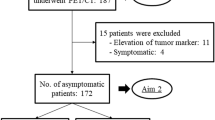Abstract
Background
Positron emission tomography with 18-fluorodeoxyglucose (FDG-PET) has been useful for the detection of recurrent lung cancer. However, such technology is expensive and is not always widely available. In this study, we evaluated the selected use of FDG-PET for lung cancer patients with re-elevated levels of serum carcinoembryonic antigen (CEA) after curative surgery.
Methods
Among 327 patients who underwent curative resection for primary lung cancer from May 2002 through March 2007, 199 had adenocarcinoma, of whom 78 (39%) had elevated levels of serum CEA before treatment. After surgery, the level was monitored every 1 to 3 months. Re-elevation of CEA was recognized in 39 (50%) patients, 22 of whom underwent FDG-PET and were included in this study. FDG-PET images were visually inspected, and abnormally increased FDG uptake was interpreted as recurrence. The sensitivity, specificity, positive predictive value, and negative predictive value of PET in detecting recurrent lung cancer were determined.
Results
FDG-PET correctly identified 14 out of 15 relapses and gave true negative results in six out of seven remissions, i.e., one false-negative and one false-positive were observed. The sensitivity, specificity, positive predictive value, and negative predictive value were 93%, 86%, 93%, and 86%, respectively.
Conclusion
In 64% of the patients with unexplained increased CEA levels, FDG-PET provided decisive diagnostic clues guiding further diagnostic and therapeutic interventions. The selected use of FDG-PET for patients with re-elevated serum CEA levels after surgery can be a practical and effective mode of surveillance for detecting recurrent lung cancer.
Similar content being viewed by others
References
Patz EF Jr, Lowe VJ, Hoffman JM, et al. (1994) Persistent or recurrent bronchogenic carcinoma: detection with PET and 2-[F-18]-2deoxy-D-glucose. Radiology 191:379–382
Duhaylongsod FG, Lowe VJ, Patz EF, et al. (1995) Detection of primary and recurrent lung cancer by means of F-18 positron emission tomography (FDG-PET). J Thorac Cardiovasc Surg 110: 130–139
Frank A, Lefkowitz D, Jaeger S, et al. (1995) Decision logic for retreatment of asymptomatic lung cancer recurrence based on positron emission tomography findings. Int J Radiat Oncol Biol Phys 32:1495–1512
Inoue T, Kim EE, Komaki R, et al. (1995) Detecting recurrent or residual lung cancer with FDG-PET. J Nucl Med 36:788–793
Ukena D, Hellwig D, Palm I, et al. (2000) Value of positron emission tomography with 18-fluorodeoxy-glucose (FDG-PET) in diagnosis of recurrent bronchial carcinoma. Pneumologie 54: 49–53
Hicks RJ, Kalff V, Macmanus MP, et al. (2001) The utility of 18F-FDG PET for suspected lung cancer recurrence: diagnostic value and impact on patient management J Nucl Med 42:1605–1613
Hellwig D, Groschel A, Graeter TP, et al. (2006) Diagnostic performance and prognostic impact of FDG-PET in suspected recurrence treated non-small cell lung cancer. Eur J Nucl Med Mol Imaging 33:13–21
Rubins J, Unger M, Colice GL (2007) Follow-up and surveillance of the lung cancer patient following curative intent therapy: ACCP evidence-based clinical practice guideline (2nd edition). Chest 132; 355–367
Bruzzi JF, Munden RF, Bruzzi JF, et al. (2006) PET/CT imaging of lung cancer. J Thorac Imaging 21:123–136
Flanagan FL, Dehdashti F, Ogunbiyi OA, et al. (1998) Utility of FDG-PET for investigating unexplained plasma CEA elevation in patients with colorectal cancer. Ann Surg 227:319–323
Flamen P, Hoekstra OS, Homans F, et al. (2001) Unexplained rising carcinoembryonic antigen (CEA) in the postoperative surveillance of colorectal cancer: the utility of positron emission tomography (PET). Eur J Cancer 37:862–869
Buccheri GF, Violante B, Sartoris AM, et al. (1986) Clinical value of a multiple biomarker assay in patients with bronchogenic carcinoma. Cancer 57:2389–2396
Sawabata N, Ohta M, Takeda S (2002) Serum carcinoembryonic antigen level in surgically resected clinical stage I patients with non-small cell lung cancer. Ann Thorac Surg 74:174–179
Buccheri G, Ferrigno D (2003) Identifying patients at risk of early postoperative recurrence of lung cancer: a new use of the old CEA test. Ann Thorac Surg 75:973–980
Okada M, Nishio W, Sakamoto T, et al. (2004) Prognostic significance of perioperative serum carcinoembryonic antigen in non-small cell lung cancer: analysis of 1000 consecutive resections for clinical stage I disease. Ann Thorac Surg 78:216–221
Sakao Y, Tomimitsu S, Takeda Y, et al. (2004) Carcinoembryonic antigen as a predictive factor for postoperative tumor relapse in early-stage lung adenocarcinoma. Eur J Cardiothorac Surg 25: 520–522
Shon IH, O’Doherty MJ, Maisey MN (2002) Positron emission tomography in lung cancer. Semin Nucl Med 32:240–271
Author information
Authors and Affiliations
Corresponding author
About this article
Cite this article
Isobe, K., Hata, Y., Takai, Y. et al. Usefulness of fluoro-2-deoxyglucose positron emission tomography for investigating unexplained rising carcinoembryonic antigen levels that occur during the postoperative surveillance of lung cancer patients. Int J Clin Oncol 14, 497–501 (2009). https://doi.org/10.1007/s10147-009-0905-4
Received:
Accepted:
Published:
Issue Date:
DOI: https://doi.org/10.1007/s10147-009-0905-4




